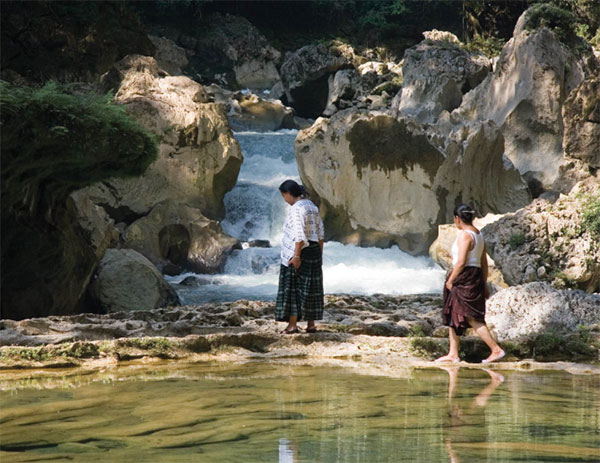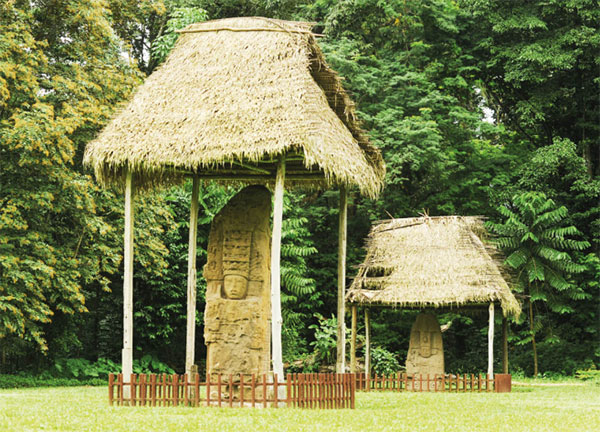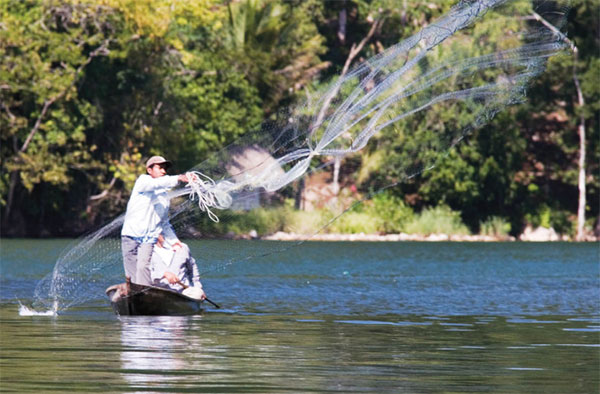Where
Orchid lovers, take note: Orquigonia (www.orquigonia.blogspot.com; Mon–Sat 9am–noon, 2–4.30pm, Sun 9am–noon) is a specialist nursery where thousands of plants, including more than 600 species of orchid, are grown. Orquigonia hosts a variety of activities, including tours and workshops, and they rent out cabins.
El Oriente
El Oriente unfolds south of the Carretera al Atlántico. This is the hottest part of Guatemala, a relentlessly uncompromising land where the thermometer regularly nudges 38˚C (100˚F). Probing the horizon are a scattering of ancient, extinct volcanoes – though much smaller in scale and more weathered in appearance than the chain across the western highlands.
One of the region’s major towns is Chiquimula ‡ [map] , which is archetypal of the region – hot, dusty, and featureless. For travelers, Chiquimula serves two key purposes: as a transit hub, and to break up the journey, as a place to stay for a night or two, thanks to its quality array of affordable lodging. The colonial church, the Iglesia Vieja, on the edge of town, was badly damaged by an earthquake in 1765 and has now been reduced to ruins.
South of Chiquimula looms Volcán de Ipala ° [map] , a 1,650-meter (5,410ft) eroded volcano with an exquisite crater lake at its rounded summit. It is a fairly easy two-hour hike to the top from the closest village of Agua Blanca. If you have your own transportation, the most direct route is up a trail that begins at Km 26.5 on the Ipala–Agua Blanca road, near to a drinks stand in the tiny settlement of Sauce. Once here, you can walk all around the forest-fringed summit of the lake in a couple of hours.

Semuc Champey.
Corrie Wingate/Apa Publications
Esquipulas
Near the border with El Salvador, Esquipulas · [map] is famous as the site of the biggest pilgrimage in Central America. The object of veneration is an image of El Cristo Negro, the Black Christ, which is housed in a colossal white basilica (tel: 7943 1108; daily, hours vary). Inside the church the atmosphere is heady with incense and smoky from burning candles, while a continuous procession of pilgrims lines up to receive a blessing, many on their knees and reciting prayers. The image itself, created from balsam wood, was carved by the fabled sculptor Quirio Cataño in the late 16th century, while the origins of the pilgrimage are thought to predate the Conquest. The main pilgrimage date is January 15, and there is a smaller event on March 9, but Esquipulas is busy throughout the whole year with pilgrims and devotees paying homage and seeking cures to ailments.

Stela J, Quiriguá.
iStock
Izabal
Fringed by the Caribbean Sea, with Belize just to the north and the Honduran coastline to the south, the low-lying department of Izabal feels totally unlike the rest of the country. The population is a polyglot assortment of ladinos, Garífuna, Caribs, and Q’eqchi’ Maya. The scenery is also different: the landscape is lush, and the heat and humidity are punishing at any time of year, creating a decidedly languid, tropical ambience.
Izabal is bounded by mountains: the Sierra del Merendón defining the Honduran border, the Sierra de las Minas to the southwest, and the Sierra de Santa Cruz to the north. In the very center of the department is Lago de Izabal, the biggest lake in the country, which drains into the Caribbean through the beautiful Río Dulce gorge.
Quiriguá ruins
The early Classic ruins of Quiriguá º [map] (daily 8am–4.30pm), a Unesco World Heritage Site set in a beautiful clearing just off the highway, are well worth investigating for their remarkable stone carvings of fine-grained sandstone stelae and giant flat boulders. Quiriguá had always been a minor site, possibly first settled in the early Classic period by an elite group from the northern Maya lowlands. It was subsequently dominated by nearby Copán, but in AD 737, the leader Cauac Sky (or Two-legged Sky) captured and sacrificed Copán’s ruler 18 Rabbit, turning centuries of Maya power politics upside down.
To celebrate this success, Cauac Sky started rebuilding Quiriguá, commissioning the carving of the largest stelae anywhere in the Maya world, which were grouped around an enormous monumental plaza, enclosed on three sides by an acropolis.
The site’s largest stela is Stela E, 8 meters (25ft) tall, which depicts Cauac Sky crowned with an elaborate headdress. There are 10 other stelae in the plaza, a small acropolis to the south, and a ball court. Don’t miss the six fantastic carved boulders just below the acropolis, which are decorated with images of frogs, turtles, jaguars, and snakes.
Lake Izabal
North of Quiriguá is Lago de Izabal, a huge freshwater expanse which is steadily being opened up to tourism. The western environs of the lake are protected as part of the Bocas del Polochic preserve, where there are alligators, iguanas, and a riot of colorful birdlife. Most people stay at the eastern edge of the lake at the town of Río Dulce ¡ [map] . The town, scattered on both sides of the bridge, is no beauty, functioning mainly as a transportation hub, but unexpectedly close by there are some delightful hotels that are well placed for exploring the lake.
Back in the 16th and 17th centuries, British pirates caused mayhem around Izabal, raiding Spanish merchant caravans, and the Castillo de San Felipe (daily 8am–5pm; charge), just 3km (2 miles) from Río Dulce town, was built to combat these marauding buccaneers. There’s a lot more to see around the lake, including an incredible hot spring waterfall near Finca El Paraíso, which drops about 12 meters (40ft) into a deep pool.
Livingston
At the point where the Río Dulce meets the Bahía de Amatique is the Garífuna town of Livingston ™ [map] , sometimes known locally as La Buga (The Mouth). Livingston is one of the most interesting villages in Guatemala, its atmosphere seemingly much more in tune with Jamaica or the Honduran Bay Islands than the Central American mainland. Connections with the rest of Guatemala are somewhat tentative, and not just culturally, as Livingston can only be reached by boat from Puerto Barrios, Belize, or Honduras.

Fisherman at Río Dulce.
Corrie Wingate/Apa Publications
Good excursions from Livingston include the impressive series of waterfalls called Siete Altares (best in the rainy season); one of the best beaches in Guatemala, Playa Blanca; and even snorkeling trips to the edge of the Belizean reef system. A variety of tour companies offer trips – check with your hotel for recommendations.